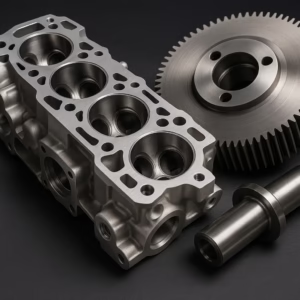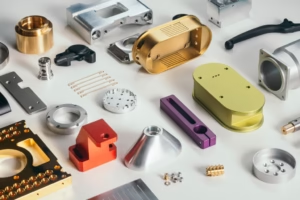What is Cold Forging And How Does It Work?
Cold forging is a metal shaping technique where metal bar stock is placed into a die and pressed into another closed die at ambient temperature or lower than the metal’s austenite temperature.
This process is highly efficient and cost-effective for producing large quantities of components. Forging methods can be categorized into cold, warm, and hot forging, all forgings involve tools such as hammers, dies, or presses to shape and deform the metal. It should be distinguished from machining and casting, as it results in a product that is stronger and of superior quality.
Unlike warm or hot forging, cold forging manipulates the metal at room temperature, using localized compressive forces to achieve the desired shape. Depending on the part’s design, the metal may be subjected to multiple dies or repeated strikes to reach the final form.
How Does It Work?
Cold forging offers significant cost savings due to reduced labor and the elimination of additional processing. Parts can be manufactured at high speeds – up to 1000 units an hour! – which further lowers per-piece costs. This process entails feeding metal coils into machines that perform the work quickly and efficiently.
The Cold Forging Process
Step 1: Lubricant
Before the forging process begins, the workpiece is often coated with a lubricant. This helps to prevent adhesion to the die and maintains a lower temperature during forming, as deformation can generate heat ranging from 250°C to 450°C. The application of lubricants varies by manufacturer and their specific methods, and they are not universally employed in all processes.
Step 2: Feeding the Metal Coil
The metal coil is introduced into the forging machine, positioned above a die that is shaped to form the final part. This die typically consists of two segments: one attached to the hammer, and the other positioned beneath the workpiece. The hammer, which is the upper part of the mechanism, delivers the force necessary to shape and deform the metal.
Step 3: The Stroke
Three primary mechanisms can be used to strike the workpiece: hydraulic, pneumatic, or mechanical. Each method employs a shaft with an attached hammer that descends with significant force onto the workpiece to achieve the intended shape. This process occurs in milliseconds. Occasionally, multiple hammer strikes may be necessary in rapid succession to achieve the precise contour and dimensions required.
Step 4: Part Removal
The method of part removal varies with the specific process used. In contemporary manufacturing, automation often handles this task through conveyors or robotic arms. This approach reduces costs by eliminating the need for manual material handling.
Step 5: After Shaping
The approach to handling parts post-forging varies depending on their complexity. Single-die, single-stroke parts are typically trimmed and forwarded to shipping directly. Additional die processes are required to incorporate various features for more intricate components.
What are the benefits of cold forging?
1. High Precision:
Cold forging allows the production of parts with tight tolerances and complex geometries. The process requires precise control over die dimensions, punch forces, material flow and die alignment; ultimately producing components requiring minimal additional machining work – an attribute particularly valuable in industries where exact specifications are key, such as automotive and aerospace manufacturing.
2. Superior Surface Finish:
Compared to hot forging or other metal forming methods, cold forging typically produces parts with excellent surface smoothness and finish. The absence of high temperatures reduces oxidation and scale formation on the metal surface, eliminating or minimizing the need for secondary finishing processes like grinding or polishing.
3. Material Savings:
Cold forging has long been recognized for its efficient material utilization efficiency. This process involves shaping metal without significant material loss, making it an attractive solution when cost and waste reduction are top priorities. Manufacturers can maximize material savings by designing dies and processes that minimize scrap generation for enhanced cost-effectiveness and sustainability in production.
4. Improved Mechanical Properties:
Cold forging allows for the production of parts with tight tolerances and complex geometries, using precise control over die dimensions, punch forces, material flow, and material removal – often with minimal additional machining required post-production.
5. Design Flexibility:
Cold forging allows for the production of complex shapes and configurations that may be difficult or costly to achieve through other manufacturing methods. The versatility of cold forging dies enables the creation of various part geometries, including asymmetrical and multi-dimensional forms, thereby expanding design possibilities for engineers and product designers.
6. Cost-Effectiveness:
Despite requiring specialized equipment and tooling, cold forging offers long-term cost benefits due to reduced material waste, lower energy consumption (compared to hot forging), and minimal need for secondary operations.
7. Environmental Benefits:
Cold forging aligns with sustainable manufacturing practices by minimizing material waste, reducing energy consumption, and lowering carbon emissions associated with heat-intensive processes.
Disadvantages of Cold Forging
Cold forging is not without its drawbacks. As with any production method, it has its limitations and constraints that should be considered before selecting it for your next project.
1. Only simple shapes and designs in high volumes can be produced. Unique, unusual, or intricate patterns cannot be cold-forged. Deformation levels and shaping grades are limited, and cold-forged metals have less ductility.
2. The alteration of the grain structure of a metal gives it extra strength but may produce residual stress.
3. Certain methods of cold forging require heat treatments to eliminate possible cracks or creep hardening.
4. There is a limitation to the types of metals that can be cold forged. Ones with low ductility and sensitivity to strain hardening should not be chosen since they lose their ductility and will break under tensile stress. Only metals with a hardness of HRC 44 on the Rockwell scale can be used.
5. Production processes require a great deal of force to produce the necessary compressive force and pressure. Though the addition of hydraulics and pneumatics has decreased the size of the equipment, it has not eliminated the amount of power the machines consume.
6. Tools, dies, and molds have to be specially designed as well as sturdy and strong enough to be able to endure the constant repetitive force. The beating that cold forging tools endure requires that they be replaced frequently.
What are the different processes involved in cold forging?
Technological advancements and progress in metal processing have led to the creation of various cold metal shaping and forming techniques. While each method caters to specific needs, they are all optimized for efficient and rapid production, often eliminating the need for additional finishing steps.
The eight most widely used cold forging methods include:
- Bending
- Cold rolling
- Closed die
- Drawing
- Extrusion
- Open die
- Ring forging
- Swaging
When searching for a cold forging manufacturer, you’ll encounter more methods than the eight discussed here. Understanding these basic methods will enable you to engage knowledgeably with producers and interpret industry terminology effectively.
If you have any needs, contact us via email at Lynnyao@prototekparts.com oder Telefon: +86-0792-86372550
Tags:
- Kaltschmieden

























































